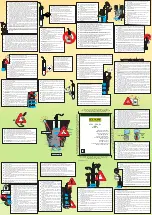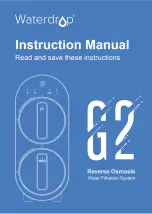
12
Copyright © 2021, Waterite, Inc. All Rights Reserved
SECTION 3: SYSTEM MAINTENANCE
3.1. Pre-Filter Maintenance
Feed water quality will affect the pre-filter service life. A pressure differential between the pre-filter pressure and post-filter pressure
gauges greater than 10 PSI indicates the need to replace the filter. This is critical to ensure the pre-treatment filter will allow the
necessary flow and that suspended particulate is removed from the feed water. This will increase membrane lifespan and improve
production.
3.2. Pre-Filter Replacement
Rubber/Nitrile gloves must be used to prevent microbial contamination.
1.
Turn off the system’s power as a safety precaution.
2.
Shut off the water supply to the unit.
3. Depressurize system by pressing red purge button (Figure 3)
4.
Remove the filter housing by turning counterclockwise with the housing wrench supplied. (Figure 3)
5.
Remove used filter from housing. Inspect inside of housing for sediment / scale. Clean and rinse.
6. Dry thoroughly with clean, lint free cloth or compressed air.
7. Inspect O-ring for damage and verify it is seated correctly. (Figure 4)
8.
Remove all plastic wrapping from filter cartridge. Insert the new filter in the housing and reassemble. –
DO NOT OVERTIGHTEN
– 1/4 turn after hand tight using the supplied filter wrench is usually sufficient. Always use Waterite factory replacement
cartridges.
9. Turn on water supply.
10.
Purge the air from the filter housing by depressing the red purge button until water comes out. (Tip: place towel over purge
button to catch escaping water) (Figure 3)
11.
Wipe area dry and inspect for leaks. If water is leaking from filter housing seal, repeat steps 2-9.
12. Turn on power.
3.3. Membrane Service Life
If you notice a decrease in production from your system, different taste to your drinking water or an increase in Product TDS, this
signifies that your membrane(s) are deteriorating and losing effectiveness. On units with multiple membranes, replace them at the same
time. Where the RO unit is used for pre-treatment requiring water to exact standards, regular ongoing sampling and testing procedures
are necessary to ensure compliance.
Figure 13
Figure 14
Figure 12










































